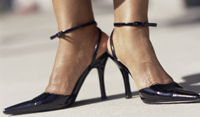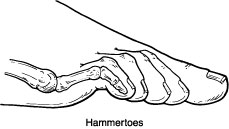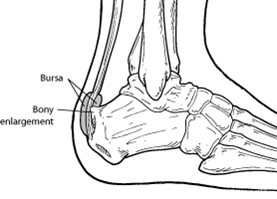In Women's Shoes, Pain Does Not Equal Gain

High-heeled shoes can cause pain, deformities and damage to the feet that can last a lifetime. But doctors say there are steps women can take to reduce high heel-related foot problems.
- Avoid shoes with pointed toes.
- Avoid heels taller than two inches.
- Recognize foot pain as a warning sign.
High-heeled shoes crowd the toes, force the body's weight onto the ball of the foot and disrupt the body's alignment. They can lead to a laundry list of problems for women and their feet:
Bunions
High heels do not cause bunions. Most women who develop bunions can blame their ancestors for passing down a faulty foot structure. But over time, wearing pointed-toe high heels can make bunions worse. Only surgery can correct this often painful deformity.
Corns
Corns usually form from repeated pressure on the skin. Women with foot deformities, such as hammertoes, often suffer from corns because the tops of the bent toes rub against the tops or sides of shoes.
Hammertoes
High-heeled shoes that crowd the toes together can contribute to hammertoes. This deformity occurs when the second, third, fourth or fifth toes become bent like a claw. This can cause constant shoe friction, leading to painful corns. Severe hammertoes may require surgery to relieve pain.
Haglund's Deformity or "Pump Bump"
Pump-style shoes often cause significant pain by irritating a bony deformity some women have on the back of their heel, called a "pump bump." This problem is common in young women who wear high heels almost every day. In many cases, it can lead to blisters, bursitis or Achilles tendonitis.
Neuromas
Pointed-toe and high-heeled shoes are the most common reasons why women develop painful neuromas. High-heeled shoes can cause the toes to be forced into the toe box, which can compress and swell nerves in the foot, especially between the third and fourth toes. Neuroma symptoms appear gradually and include tingling, burning, numbness or pain. Without treatment, a neuroma can lead to permanent nerve damage, making it difficult to walk without severe, shooting pain.
Ankle Sprains
High heels increase the risk for ankle sprains. Sprains occur when ligaments that connect bones together are stretched or torn. Left untreated, sprains can lead to chronic ankle instability and potential arthritis.
Back Pain
High heels force women to stand and walk unnaturally, affecting the alignment of the ankles, knees, hips and lower back.
Foot and ankle surgeons say the majority of their patients are women. But not all foot problems related to wearing high heels require surgery. Luckily, many of these conditions can be treated nonsurgically with changes in shoe wear, padding, orthotics (shoe inserts), pain medications and other measures.
Women's high-heeled shoes are not going out of style anytime soon. But by recognizing pain as a warning sign, wearing high heels in moderation and seeking medical care when problems are in their early stages, women can stay fabulous on their feet.